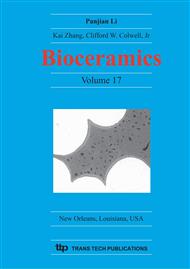p.589
p.593
p.597
p.603
p.607
p.611
p.615
p.619
p.623
Development of Controlled Heterogeneity on a Polymer-Ceramic Hydrogel Scaffold for Osteochondral Repair
Abstract:
Due to its intrinsically poor repair potential, injuries to articular cartilage do not heal and clinical intervention is required. Osteochondral grafts may improve healing while promoting integration with host tissue. We report here the development of an osteochondral graft based on a hybrid of a hyrogel and a polymer-bioactive glass composite (PLAGA-BG) microsphere scaffold. This novel osteochondral construct consists of three regions: gel-only, gel/composite interface, and a composite-only-region. The three phases differ in calcium phospate (Ca-P) or BG content. The objective of the current study is to investigate the effects of scaffold composition on chondrocyte response, and to evaluate the effects of co-culture on osteoblasts and chondrocyte growh and differentiation on the hybrid scaffold. The PLAGA-BG microsphere scaffold supported the growth of chondrocytes and initial results indicate that in the presence of BG, chondrocyte-mediated mineralization may be stimulated. Co-culture of osteoblasts and chondrocytes on the multi-phased scaffold with varied Ca-P content facilitated the formation of multiple matrix zones: a GAGrich chondrocyte region, an interfacial matrix rich in GAG+collagen, and a mineralized collagen matrix with osteoblasts. In summary, chondrocyte response has been optimized as a function of scaffold composition and the novel osteochondral graft has the potential to support the simultaneous formation of multiple types of tissue in vitro.
Info:
Periodical:
Pages:
607-610
Citation:
Online since:
April 2005
Authors:
Price:
Сopyright:
© 2005 Trans Tech Publications Ltd. All Rights Reserved
Share:
Citation:


